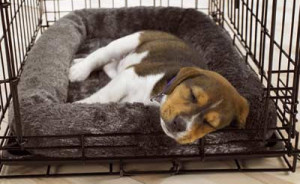Training A New Puppy?
 Many people might have acquired a new addition to their family over the holidays-namely a new puppy. Training is probably the single most important step in raising your puppy to make ownership a positive experience.
Many people might have acquired a new addition to their family over the holidays-namely a new puppy. Training is probably the single most important step in raising your puppy to make ownership a positive experience.
This training includes puppy crate training. Puppy crate training is a fantastic method of managing the safety and well-being of young puppies. When used properly, the crate is an invaluable tool for establishing good habits in your puppies and also for preventing problem behaviors before they arise. In spite of what you may think or have read about puppy crate training, the truth is that we crate train puppies for their benefit – that is why we do it.
Over time the crate will become your puppy’s own private area for which they will grow to love and feel secure in. You will come to rely on your crate to supply many important benefits such as puppy housebreaking and establishing good habits along with preventing destructive habits which we can rectify. Another benefit from crating your puppy include protecting it from dangerous household items such as wires, poisons and foreign objects.
Proper use of the crate can help reduce the chance of your puppy developing separation anxiety. Separation anxiety is becoming a huge problem for an increasingly large percentage of dogs. The crate will become a place where your dog is calm, out of trouble and accustomed to being alone.
When puppy crate training is applied correctly, your puppy cannot get into any mischief which significantly reduces any need to discipline it. Also it makes trips and stays such as to your veterinarian or dog groomer a more bearable experience. This makes for a far better environment in which to live for both the dog and the owner.
Besides the crate, I recommend that the puppy is provided with a nice comfortable dog bed or blanket in the crate that cannot be destroyed or chewed up. Some chew toys that will keep the puppy occupied when in the crate, and a good clean supply of water. It is best to have the water in a bowl that has a heavy wide base to prevent spillage in the cage.
In introducing your puppy to the crate, it is important that your puppy’s first impression and experiences with the crate are not traumatic. We need to set it up so that your puppy views the crate as a positive object right from the start. Your goal is for your puppy to love the crate and choose to use it rather than as a contraption it associates with isolation and loneliness.
I am going to offer a few tips that may make the crate more inviting to your puppy, But remember, always take it slow. It may work best to put the crate in the room with you and leave the door open wide to start out. A central room or a large hallway may work best.
- Occasionally throughout the day, drop small pieces of kibble or dog biscuits in the crate. While investigating his new crate, the pup will discover edible treasures, thereby reinforcing his positive associations with the crate. You may also feed him in the crate to create the same effect. If the dog hesitates, it often works to feed him in front of the crate, then right inside the doorway and then finally, in the back of the crate.
- In the beginning, praise and pet your pup when he enters. Do not try to push, pull, or force the puppy into the crate. At this early stage of introduction only inductive methods are suggested. Overnight exception: You may need to place your pet in his crate and shut the door upon retiring. (In most cases, the crate should be placed right next to your bed overnight. If this is not possible, the crate can be placed in a kitchen, bathroom or living room.)
- You may also play this enjoyable and educational game with your pup or dog: without alerting your puppy, drop a small biscuit into the crate. Then call your puppy and say to him, “Where’s the biscuit? It’s in your room.” Using only a friendly, encouraging voice, direct your pup toward his crate. When the puppy discovers the treat, give enthusiastic praise. The biscuit will automatically serve as a primary reward. Your pup should be free to leave its crate at all times during this game. Later on, your puppy’s toy or ball can be substituted for the treat.
- It is advisable first to crate your pup for short periods of time while you are home with him. In fact, crate training is best accomplished while you are in the room with your dog. Getting him used to your absence from the room in which he is crated is a good first step. This prevents an association being made with the crate and your leaving it alone.
One thing that you NEVER want to do is to use the crate as a tool for punishment. This causes the puppy to fear and resent the crate. If your puppy is correctly introduced to its crate, your puppy should be happy to go into the crate anytime.
Dog crates give your dog a place that he can claim as his territory. We just want to make sure it doesn’t interfere with yours. Providing your puppy with a comfortable room of his own will help keep it off furniture. In addition to the safety and comfort benefits, it will help minimize you and your puppy’s frustrations.
For any questions, just give us a call. We can’t wait to meet your newest addition!
